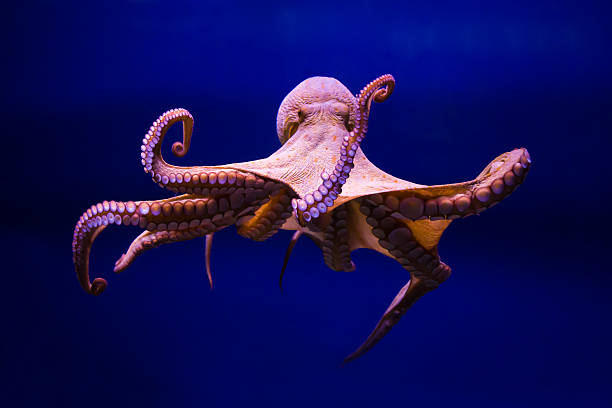Aquatic Acrobats: The Surprising Athleticism of Octopuses
Discovering the hidden talents of ocean dwellers can be a mesmerizing experience. Among the most intriguing creatures of the deep, octopuses stand out for their remarkable physical abilities. These cephalopods are not just intelligent; they're also incredibly agile and possess a surprising level of athleticism that challenges our understanding of marine life.

The Fluid Physiology of Octopuses
At the heart of an octopus’s athletic prowess lies its unique physiology. Unlike vertebrates, octopuses lack a rigid skeleton, which allows them to contort their bodies into almost any shape imaginable. This flexibility is made possible by their muscular hydrostat system, a complex network of muscles that provides both structure and movement.
The octopus’s body is composed primarily of soft tissue, with approximately 60% of its neurons located in its arms. This distributed nervous system allows for incredible dexterity and coordination, enabling the octopus to perform complex movements with each arm independently. The absence of bones also means that an octopus can compress its body to fit through openings as small as its beak, the only hard part of its anatomy.
Masters of Escape and Evasion
One of the most impressive displays of octopus athleticism is their escape artistry. When threatened, octopuses can employ a variety of techniques to evade predators. Their jet propulsion system allows them to shoot through the water at speeds of up to 25 miles per hour, making them one of the fastest marine invertebrates.
In addition to speed, octopuses are masters of camouflage. They can change their skin color and texture in milliseconds to blend seamlessly with their surroundings. This rapid transformation is not just a passive defense; it requires precise control over thousands of specialized cells called chromatophores, iridophores, and leucophores. The ability to manipulate these cells with such speed and accuracy is a testament to the octopus’s athletic control over its body.
Strength and Dexterity in Eight Arms
The octopus’s arms are marvels of natural engineering. Each arm contains about 240 suckers, each of which can be controlled independently. These suckers are not just for gripping; they also contain chemoreceptors that allow the octopus to taste and smell its environment. The strength of these arms is remarkable, with some species capable of lifting up to 40 times their own body weight.
The dexterity of octopus arms is equally impressive. They can perform complex manipulations, such as unscrewing jar lids or solving puzzles. This fine motor control, combined with their problem-solving intelligence, allows octopuses to navigate complex underwater environments and manipulate objects with precision that would be challenging even for humans with opposable thumbs.
Acrobatic Hunting Techniques
Octopuses employ their athletic abilities in sophisticated hunting strategies. Some species, like the blanket octopus, use a unique technique called arm autotomy. They can detach and regrow their arms, using them as decoys to distract predators or as lures to attract prey. This ability to sacrifice and regenerate limbs showcases the octopus’s remarkable adaptability and resilience.
Other species, such as the coconut octopus, demonstrate tool use in their hunting. They have been observed collecting coconut shells and using them as portable shelters, carrying them across the ocean floor and assembling them when needed. This behavior requires not only intelligence but also significant physical coordination and strength.
The Evolutionary Significance of Octopus Athleticism
The athletic abilities of octopuses are not merely impressive; they are crucial to their survival and evolutionary success. These skills have allowed octopuses to thrive in diverse marine environments, from shallow coral reefs to the deep ocean. Their physical prowess, combined with their intelligence, has enabled them to outsmart predators and compete effectively for resources in challenging underwater ecosystems.
Studying octopus athleticism has implications beyond marine biology. Researchers in fields such as robotics and materials science are drawing inspiration from octopus physiology to develop new technologies. Soft robotics, in particular, looks to mimic the flexibility and strength of octopus arms to create more adaptable and efficient machines.
Challenges in Studying Octopus Athletics
Despite the fascinating insights gained so far, studying octopus athleticism presents unique challenges. Their natural habitat in the ocean depths makes direct observation difficult, and their intelligence often leads to unpredictable behavior in captivity. Advanced imaging techniques and underwater robotics are being developed to better capture and analyze octopus movements in their natural environment.
The cost of these research efforts can be substantial, with specialized equipment for deep-sea observation often ranging from $50,000 to several million dollars. However, the potential applications of this research in fields like biomechanics, neuroscience, and engineering continue to drive investment in this area.
The Future of Octopus Research
As our understanding of octopus athleticism grows, so does our appreciation for these remarkable creatures. Future research aims to delve deeper into the neurological basis of their physical abilities, potentially unlocking new insights into motor control and coordination. There is also growing interest in the conservation of octopus habitats, recognizing the importance of preserving these unique animals and the ecosystems they inhabit.
The study of octopus athleticism serves as a reminder of the incredible diversity of life on our planet. As we continue to explore the depths of the oceans, we may yet discover even more surprising abilities in these and other marine creatures, further expanding our understanding of the natural world and inspiring new innovations in science and technology.





